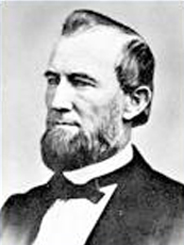
"I believe that ironclads and such matters are with me a kind of monomania." — from a letter to Assistant Secretary of the Navy G.V. Fox, 1863
James Eads began learning about the hazards of the Mississippi River early in life. When he was 13, the riverboat delivering him and his family to St. Louis caught on fire, killing eight people. Family members escaped but lost everything they owned. Eads was obliged to leave school and sell apples in the street to help support the family. Later he found work as a clerk in a dry goods business and resumed his education by reading the library of the store's proprietor. Also at the age of 13, Eads went to work on the river, starting as a "mud clerk " on the steamboat Knickerbocker. But that went awry as the ship struck a snag in the murky water and sank. Inspired by the dangers of river travel, Eads began designing a salvage vessel with an accompanying diving bell for retrieving cargo from sunken boats.
In 1842, he took the plans to boat-builders Calvin Case and William Nelson, proposing that they become his partners in a salvage business. The two men agreed to join in the venture, and soon Eads was walking the river bottom in his diving rig, bringing up valuable items like lead and iron pigs that the ships had been carrying. (A pig is a crude casting of iron or lead meant for shipment to fabricators.) Later he designed a more sophisticated system that included centrifugal pumps and hoists that could re-float whole sunken vessels. By 1844, he had made a fortune in salvage work and resolved to give up diving in favor of opening a glass factory, but the venture was unsuccessful. He returned to salvage operations four years later, then retired with another fortune of $500,000 in 1857. As the Civil War loomed on the horizon, Eads proposed that the U.S. Navy build a fleet of ironclad boats to patrol important waterways. The government's response was cool, but when war actually came, the Navy quickly changed its mind. Eads' first four ironclads were built in fewer than 100 days, and in 1862, the gunboats proved instrumental in capturing Fort Henry and Fort Donelson on the Cumberland River. They also supported Union forces in the siege of Vicksburg, Mississippi and in the victory at Mobile Bay, Alabama.
After the war, Eads turned his attention to the construction of a bridge across the Mississippi at St. Louis, a project that would have to overcome not only immense engineering challenges, but also the skepticism of his peers, opposition from the U.S. Army Corps of Engineers, and the caisson disease that threatened his workers. He created a floating hospital to care for ailing workers; he prevailed on President Ulysses S. Grant to prevent the army from digging a canal around the bridge. Demonstrating a flair for showmanship, he tackled skepticism about the bridge's soundness by ordering an elephant to be led across it - it was widely believed that elephants had a sixth sense and would refuse to cross an unsound structure. Then he tested the bridge by having 14 locomotives drive back and forth over it. The Eads Bridge officially opened on July 4, 1874. Eads next undertook a project to open a channel for shipping through the Mississippi River Delta at New Orleans by building a series of jetties that would accelerate the flow of water and prevent the buildup of silt. The project became known as the Eads South Pass Navigation Works.
By 1876, effect of the jetties had deepened the channel from 8 feet to 20 feet, and oceangoing ships began using it routinely. In 1880, New Orleans officials estimated the new channel had increased shipping to the port by 6,500 percent. Eads also planned a "ship railway " that would carry vessels across Mexico, shortening the trip from the Atlantic Ocean to the Pacific by thousands of miles. But this last grand project was not to be — the U.S. government took no action on Eads' proposal, and he died before he could realize that vision. He was both celebrated and controversial in his own time — the editors of Scientific American magazine called on him to run for president in 1876, heralding him "a man of genius, of industry, and of incorruptible honor."
Resources: Dorsey, Florence L., Road to the Sea: The Story of James B. Eads and the Mississippi River, Firebird Press, 1947.

